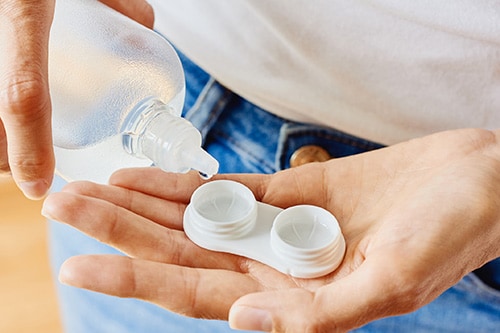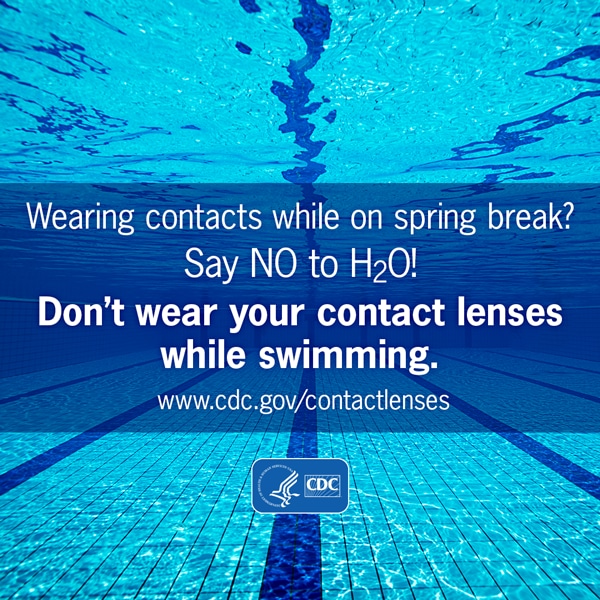Water and Contact Lenses Don’t Mix

Many people who wear contact lenses do not know that contact lenses and water are a bad combination—even when showering, swimming, or using a hot tub 1-4.
Water can cause soft contact lenses to change shape, swell, and stick to the eye. This is uncomfortable, and can scratch the cornea (the clear dome that covers the colored part of the eye), which makes it easier for germs to enter the eye and cause infection.
Most water is not germ-free. There are many different kinds of germs in water that can cause eye infections, but a particularly dangerous germ—an ameba called Acanthamoeba—is commonly found in tap water, lake water, well water, and other water sources 5. This germ can cause a very severe type of eye infection called Acanthamoeba keratitis, which is often very painful and difficult to treat—sometimes requiring a year or more of treatment 6-8. Although rare, this type of infection can result in the need for a corneal transplant, or blindness 9, 10.
Keep Contact Lenses Away from All Water
For contact lens wearers, it is best to remove lenses before showering, swimming, or using a hot tub—and contact lenses should never be rinsed or stored in water 1, 2, 11, 12. It is also important to wash and dry hands well before handling lenses 13-15, and to clean contact lens cases with solution rather than water to avoid contaminating the lenses with germs found in water.
For those who are actively involved in swimming or other water sports and concerned about being able to see well enough without wearing lenses, prescription goggles may be a good option—or possibly even a different form of vision correction, such as laser eye surgery.
Throw Away or Disinfect Contact Lenses that Touch Water
If water touches contact lenses for any reason, take them out as soon as possible. Throw them away, or clean and disinfect them overnight before wearing them again. This may help to reduce the risk of infection, but these recommendations are not based on scientific testing. The safest option is to keep contact lenses away from all water.
- Hammersmith KM. Diagnosis and management of Acanthamoeba keratitis. Curr Opin Ophthalmol. 2006;17(4):327-31.
- Butcko V, McMahon TT, Joslin CE, Jones L. Microbial keratitis and the role of rub and rinsing. Eye Contact Lens. 2007;33(6 Pt 2):421-3; discussion 424-5.
- Beattie TK, Tomlinson A, McFadyen AK, Seal DV, Grimason AM. Enhanced attachment of Acanthamoeba to extended-wear silicone hydrogel contact lenses: a new risk factor for infection? 2003;110(4):765-71.
- Wu Y, Carnt N, Stapleton F. Contact lens user profile, attitudes and level of compliance to lens care. Cont Lens Anterior Eye. 2010;33(4):183-8.
- Visvesvara GS, Moura H, Schuster FL. Pathogenic and opportunistic free-living amoebae: Acanthamoeba, Balamuthia mandrillaris, Naegleria fowleri,and Sappinia diploidea. FEMS Immunol Med Microbiol. 2007;50(1):1-26.
- Guerriero S, La Tegola MG, Monno R, Apruzzese M, Cantatore A. A case of descemet’s membrane rupture in a patient affected by Acanthamoebakeratitis. Eye Contact Lens. 2009;35(6):338-40.
- Dart JK, Saw VP, Kilvington S. Acanthamoebakeratitis: diagnosis and treatment update 2009. Am J Ophthalmol. 2009;148(4):487-499 e2.
- Ross J, Roy SL, Mathers WD, Ritterband DC, Yoder JS, Ayers T, Shah RD, Samper ME, Shih CY, Schmitz A, Brown AC. Clinical characteristics of Acanthamoebakeratitis infections in 28 states, 2008 to 2011. Cornea. 2014;33(2): 161-8.
- Gagnon MR, Walter KA. A case of Acanthamoebakeratitis as a result of a cosmetic contact lens. Eye Contact Lens. 2006;32(1):37-8.
- Page MA, Mathers WD. Acanthamoebakeratitis: a 12-year experience covering a wide spectrum of presentations, diagnoses, and outcomes.J Ophthalmol. 2013;2013:670242.
- Joslin CE, Tu EY, Shoff ME, Booton GC, Fuerst PA, McMahon TT, Anderson RJ, Dworkin MS, Sugar J, Davis FG, Stayner LT. The association of contact lens solution use and Acanthamoebakeratitis. Am J Ophthalmol. 2007;144(2):169-180.
- Beattie TK, Tomlinson A, McFadyen AK. Attachment of Acanthamoebato first- and second-generation silicone hydrogel contact lenses. 2006;113(1): 117-25.
- Radford CF, Minassian D, Dart JK, Stapleton F, Verma S. Risk factors for nonulcerative contact lens complications in an ophthalmic accident and emergency department: a case-control study. Ophthalmology. 2009;116(3):385-92.
- Sokol JL, Mier MG, Bloom S, Asbell PA. A study of patient compliance in a contact lens-wearing population.CLAO J. 1990;16(3):209-13.
- Collins MJ, Carney LG. Patient compliance and its influence on contact lens wearing problems. Am J Optom Physiol Opt. 1986;63(12):952-6.
